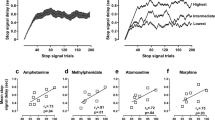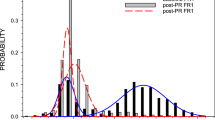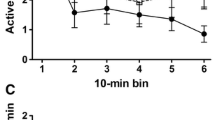Abstract
Four experiments examined the effects of d-amphetamine on response switching and perseveration in apparatus allowing a choice of response location. The relative ‘cost’ of a switch between two response locations and repetitive responding at a single location by rats was manipulated in the various test settings to provide baseline probabilities of switching. d-Amphetamine (0.2–2.3 mg/kg) increased response switching. This effect did not depend on switching being necessary to produce reinforcement and was not explained by increases in locomotor activity, motivational change or randomisation of responding. Further evidence was provided in support of a ‘probability-dependency’ hypothesis, that the effect of the drug depends in part upon the baseline probability of a response. A measure of perseveration independent of response switching (extra responses made prior to the collection of food) showed that increased switching and increased perseveration occurred in the same situation at the same doses, although perseveration generally occurred at higher doses than increased switching. Therefore the effect of amphetamine on response switching or repetition depends on the dose of drug, the context of the response and its probability of occurrence under control conditions.
Similar content being viewed by others
References
Branch MN, Gollub LR (1974) A detailed analysis of the effects of d-amphetamine on behavior under fixed-interval schedules. J Exp Anal Behav 21: 519–539
Dews PB, Wenger GR (1977) Rate-dependency of the behavioral effects of amphetamine. In: Thompson T, Dews PB (eds) Advances in behavioural pharmacology, vol 1. Academic, New York, pp 167–223
Evenden JL, Robbins TW (1983) Dissociable effects of d-amphetamine, chlordiazepoxide and α-flupenthixol on choice and rate measures of reinforcement. Psychopharmacology 79: 180–186
Hill RT (1970) Facilitation of conditioned reinforcement as a mechanism of psychomotor stimulation. In: Costa E, Garattini S (eds) Amphetamine and related compounds. Raven, New York, pp 781–795
Laties VG (1972) The modification of drug effects on behavior by external discriminative stimuli. J Pharmacol Exp Ther 183: 1–13
Laties VG, Wood RW, Cooper Rees D (1981) Stimulus control and the effects of d-amphetamine in the rat. Psychopharmacology 75: 277–282
Lea SEG, Morgan MJ (1972) The measurement of rate-dependent changes in responding. In: Gilbert RM, Millenson JR (eds) Reinforcement: behavioural analysis. Academic, New York, pp 129–145
McMillan DE (1968) The effects of sympathomimetic amines on schedule-controlled behavior in the pigeon. J Pharmacol Exp Ther 160: 315–325
Moerschbaecher JM, Thompson DM, Thomas JR (1979) Effects of methamphetamine and scopolamine on variability of response location. J Exp Anal Behav 32: 255–263
Morgan MJ (1974) Effects of random reinforcement sequences. J Exp Anal Behav 22: 301–310
Norton S (1973) Amphetamine as a model for hyperactivity in the rat. Physiol Behav 11: 181–186
Randrup A, Munkvad I (1970) Biochemical, anatomical and psychological investigations of stereotyped behaviour induced by amphetamine. In: Costa E, Garattini S (eds) Amphetamine and related compounds, Raven, New York, pp 695–713
Robbins TW (1978) The acquisition of responding with conditioned reinforcement: Effects of pipradrol, methylphenidate, d-amphetamine and nomifensine. Psychopharmacology 58: 79–87
Robbins TW (1980) Stereotypy of a learned response after apomorphine. Br J Pharmacol 69: 275–276
Robbins TW (1982) Behavioural determinants of drug action. In: Cooper SJ (ed) Theory in psychopharmacology, vol 1. Academic, New York, pp 1–63
Robbins TW, Watson BA (1981) Effects of d-amphetamine on response repetition and win-stay behaviour in the rat. In: Bradshaw CM, Szabadi E, Lowe CF (eds) Quantification of steady-state operant behaviour. Elsevier-North Holland, Amsterdam, pp 441–444
Segal DS (1975) Behavioural characterisation of d- and l-amphetamine: Neurochemical implications. Science 190: 475–477
Staddon JER, Hanson JM, Kram R (1981) Optimal choice. J Exp Anal Behav 35: 397–412
Teitelbaum P, Derks P (1958) The effect of amphetamine on forced drinking in the rat. J Comp Physiol Psychol 51: 801–810
Todorov JC, Gorayeb SRP, Correa DL, Graeff FG (1972) Effects of amphetamine on choice behavior of pigeons. Psychopharmacologia 26: 395–400
Weiss B, Gott CT (1972) A microanalysis of drug effects on fixed-ratio performance in pigeons. J Pharmacol Exp Ther 180: 189–202
Winer BJ (1971) Statistical principles in experimental design. McGraw Hill-Kogakusha, Tokyo
Author information
Authors and Affiliations
Rights and permissions
About this article
Cite this article
Evenden, J.L., Robbins, T.W. Increased response switching, perseveration and perseverative switching following d-amphetamine in the rat. Psychopharmacology 80, 67–73 (1983). https://doi.org/10.1007/BF00427498
Received:
Accepted:
Issue Date:
DOI: https://doi.org/10.1007/BF00427498




